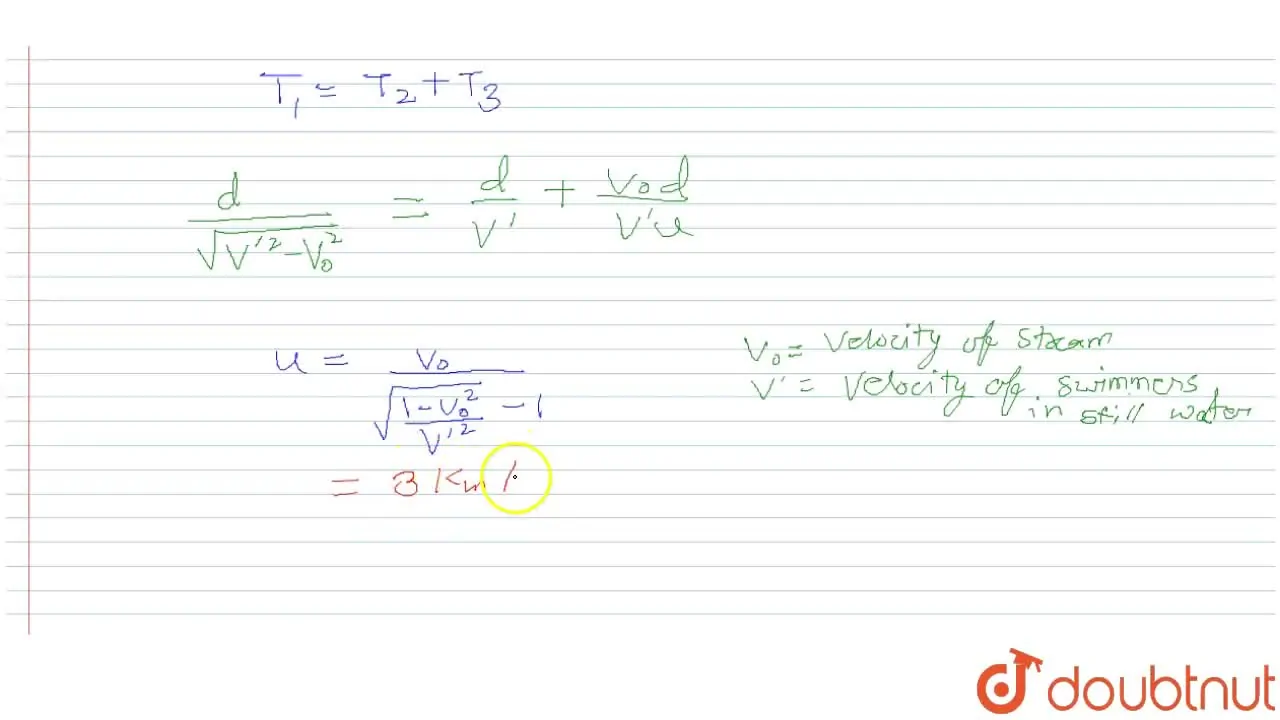Two swimmers start at the same time from point A one bank of a river to reach point B on the other bank, lying directly oppostie to point A. one of them crosses the river along the straight line AB, while the other swims at right angles to the stream and then walks the distance, which he has been carried awayby the stream to get to point B. Both swimmers reach point B at the same time. what was the velocity (assumed uniform) of his walking if velocity of both the swimmers in still water is 2.5 km h−1 and the stream velocity is 2 km h−1?

In order to reach the point C, the swimmer should start in such a way that the vector sum of →uand→v is along the line AC. For this, let the swimmer start at an angle α with line AB.
Velocity of swimmer w.r.t ground along x-axis, vx=u+vsinα
Velcoity of swimmer w.r.t ground along y -axis , vy=vcosα
Time taken to cross the river , t=ABvy=dvcosα
Displacement along x -axis.
BC=vxt
⇒dtanθ=(u+vsinα)t
Form (i) , (vcosα)=d
From (ii) , (vsinα)t=dtanθ−ut
⇒(vtcosα)2+(vtsinα)2=d2+(dtanθ−ut)2
⇒V2t2=d2+d2tan2θ+u2t2−2udttanθ
⇒(v2−u2)t2+(2udt.tanθ)−d2(1+tan2θ)=0
On sloving for roots,
t=d√v2sec2θ−u2−udtanθ(v2−u2)

Related Playlists
- BOOK - AAKASH INSTITUTE ENGLISHCHAPTER - MOTION IN A PLANEEXERCISE - llustration 1 :1videos
MOTION IN A PLANE
- BOOK - AAKASH INSTITUTE ENGLISHCHAPTER - MOTION IN A PLANEEXERCISE - Try yourself48videos
MOTION IN A PLANE
- BOOK - AAKASH INSTITUTE ENGLISHCHAPTER - MOCK_TEST_17EXERCISE - Example15videos
MOCK_TEST_17
- BOOK - AAKASH INSTITUTE ENGLISHCHAPTER - MOTION IN A STRAIGHT LINEEXERCISE - ASSIGNMENT (SECTION - D)15videos
MOTION IN A STRAIGHT LINE
Similar Questions
A T.V. Tower stands vertically on a bank of a river. From a point on the other bank directly opposite to the tower, the angle of elevation of the top of the tower is 60 degrees. From a point 20m away this point on the same bank, the angle of elevation of the top of the tower is 30o . Find the height of the tower and the width of the river.
View SolutionTwo persons P and Q crosses the river starting from point A on one side to exactly opposite point B on the other bank of the river. The person P crosses the river in the shortest path. The person Q crosses the river in shortest time and walks back to point B. Velocity of river is 3 kmph and speed of each boat is 5 kmph w.r.t river. If the two persons reach the point B in the same time, then the speed of walk of Q is
View Solutionman wants to swim across a river of which 200 m along the shortest path . If the speed of river stream is 3kmh−1 and speed of swimmer in still water is 5kmh−1 , then the time of crossing the river is
View SolutionA person swims at 135° to current of river, to meet target on reaching opposite point. The ratio of person's velocity to river water velocity is
View SolutionA man swims from a point A on the bank of a river if width 100m. When he swims perpendicular to the water current, he reaches the other bank 50m downstream. The angle to the bank at which he should swim, to reach the directly opposite point B on the other bank is.
 .View Solution
.View SolutionA man can swim in still water at a speed of 6 kmph and he has to cross the river and reach just opposite point on the other bank. If the river is flowing at a speed of 3 kmph, he has to swim in the direction
View SolutionA person, reaches a point directly opposite on the other bank of a flowing river, while swimming at a speed of 5 m/s at an angle of 120∘ with the flow. The speed of the flow must be
View SolutionA man who can swin at the rate of 2 kmhr)(in still river) crosses a river to a point exactly opposite on the other bank by swimming in a direction of 120∘ to the flow of the water in the river. The velocity of the water current in kmhr is
View SolutionA statue 8 meters high standing on the top of a tower 64 meters high, on the bank of a river, subtends at a point A on the opposite bank, directly facing the tower, the same angle as subtends at the same point A by man of height 2 meters standing at the base of the tower. Prove that the breadth of the river is 16√6 meters.
View SolutionA person standing on the bank of a river observers that the angle subtends by a tree on the opposite bank is 60∘. When he retires 40 feet from the bank, he finds the angle to be 30∘. Find the height of the tree and the breadth of the river.
View Solution


